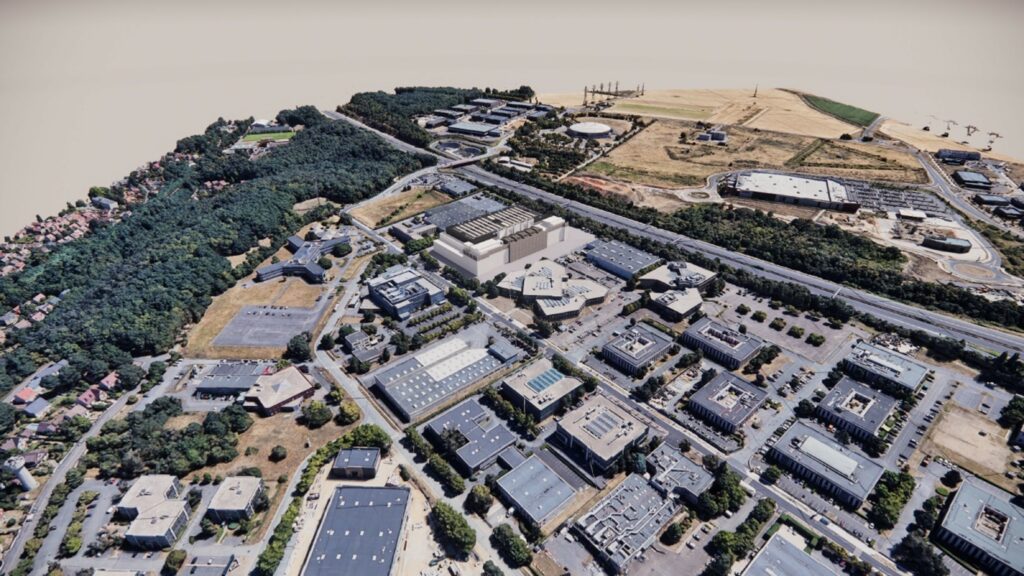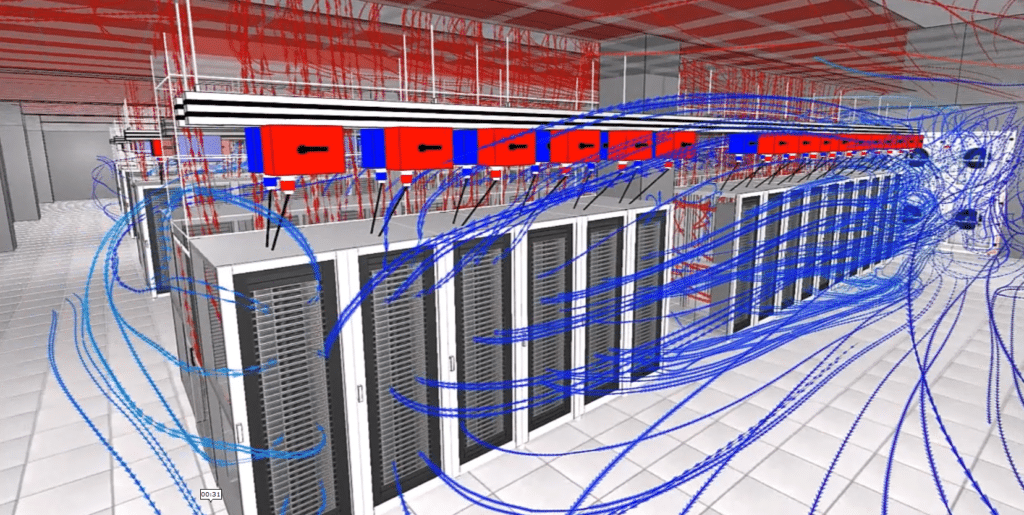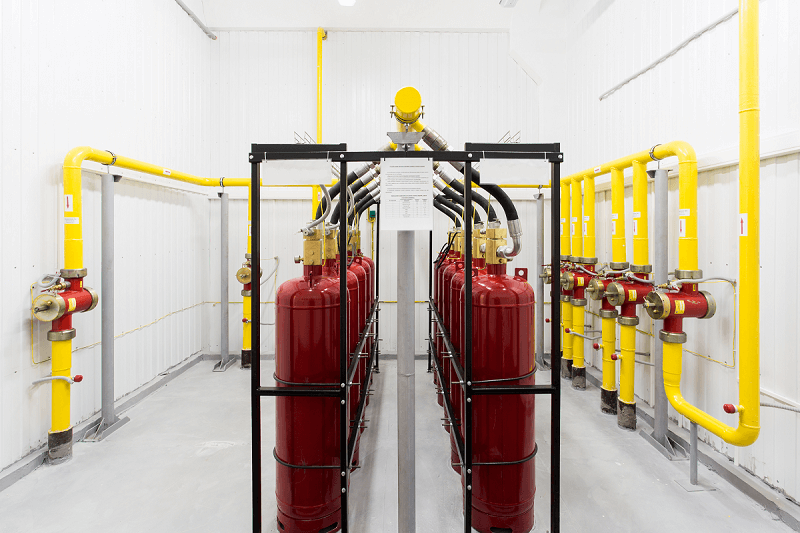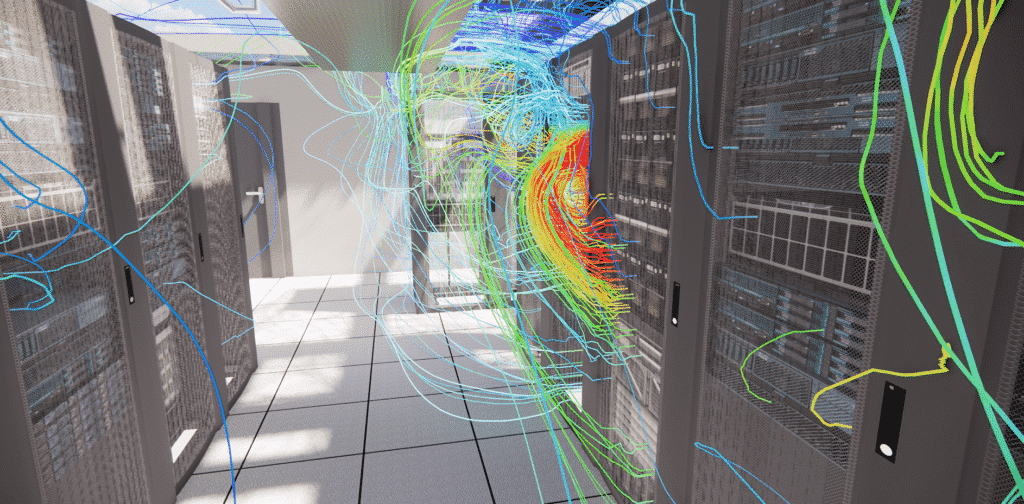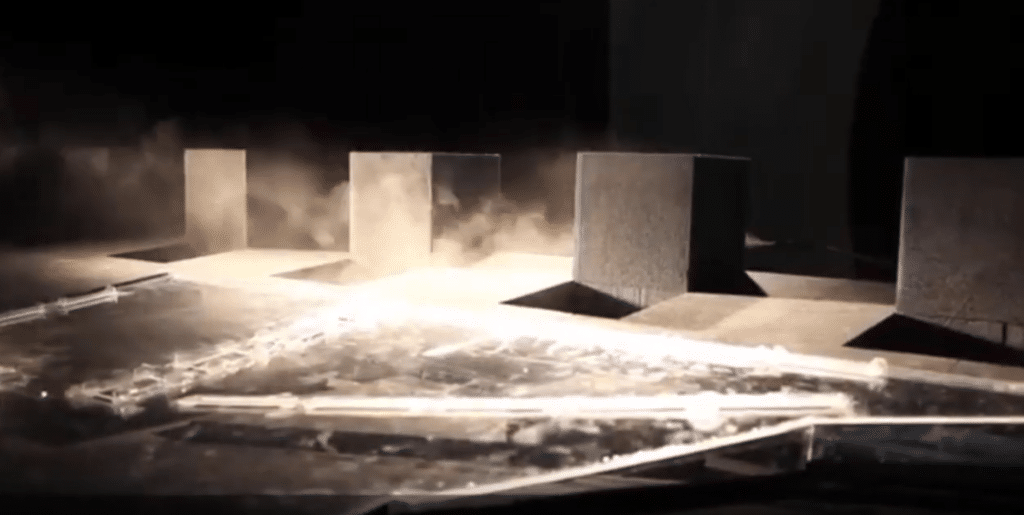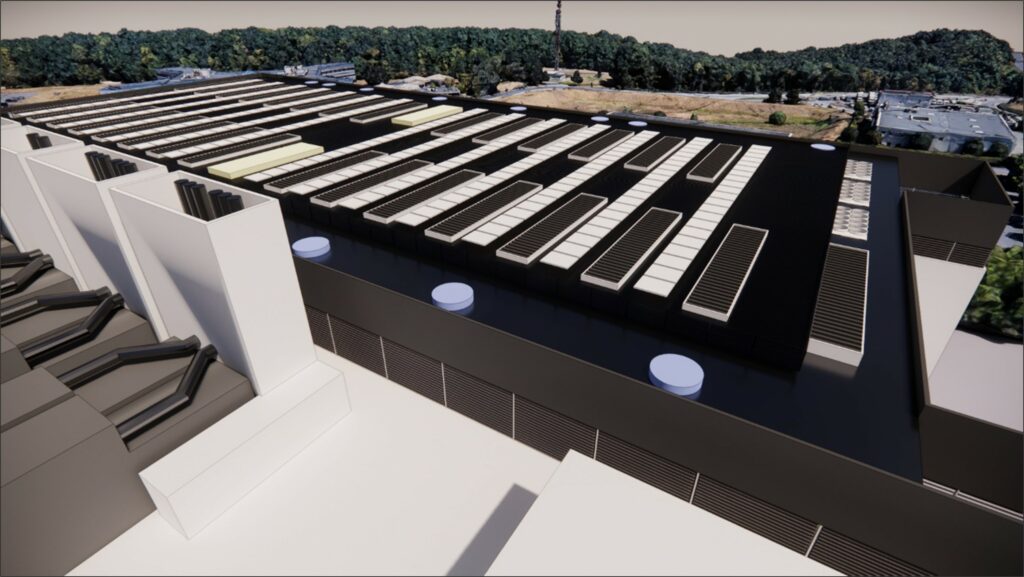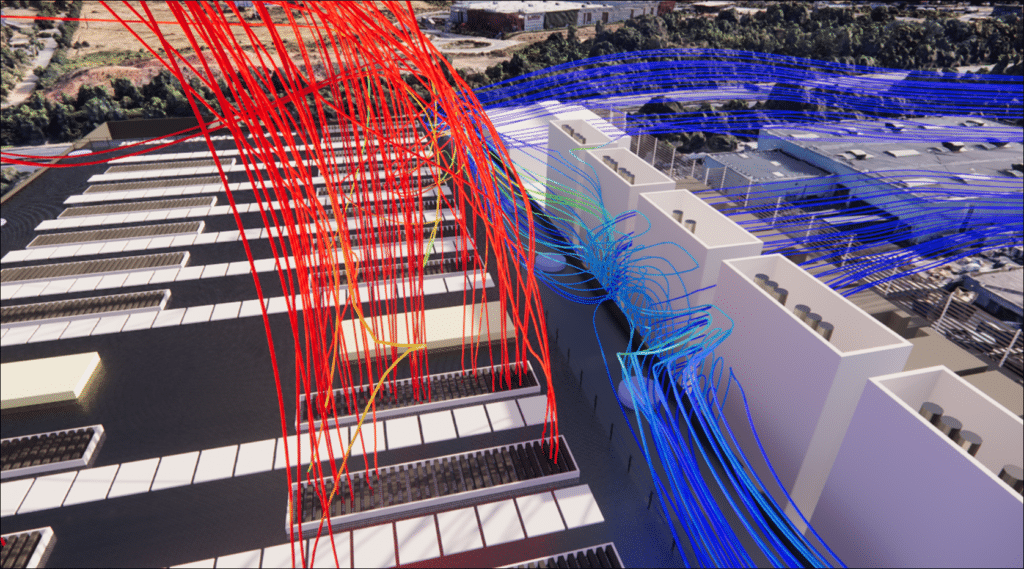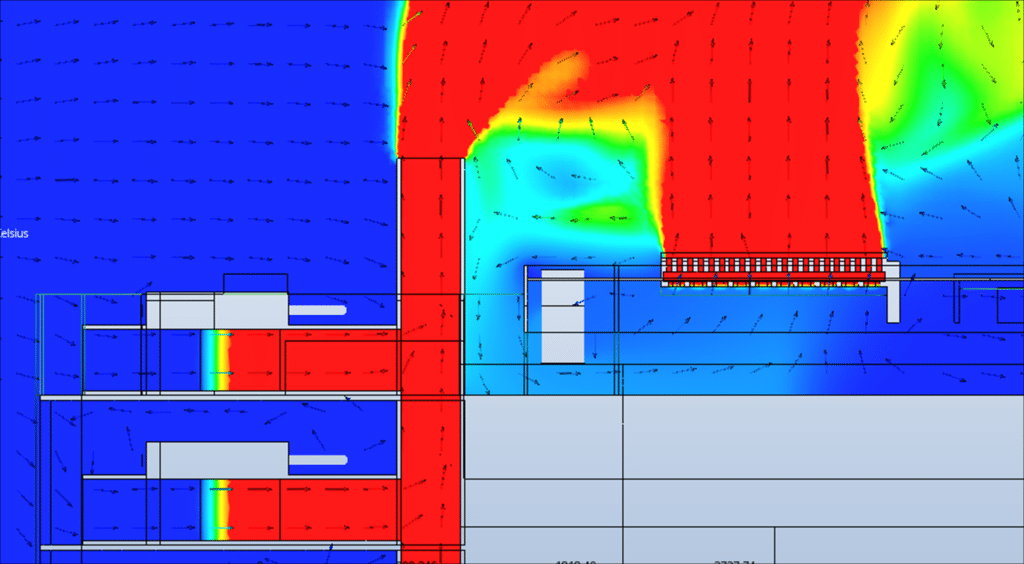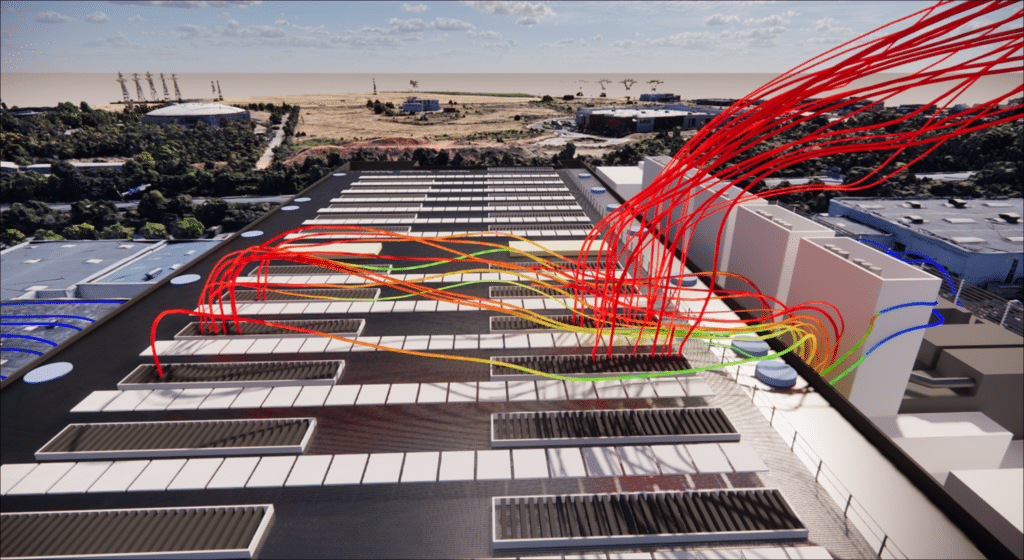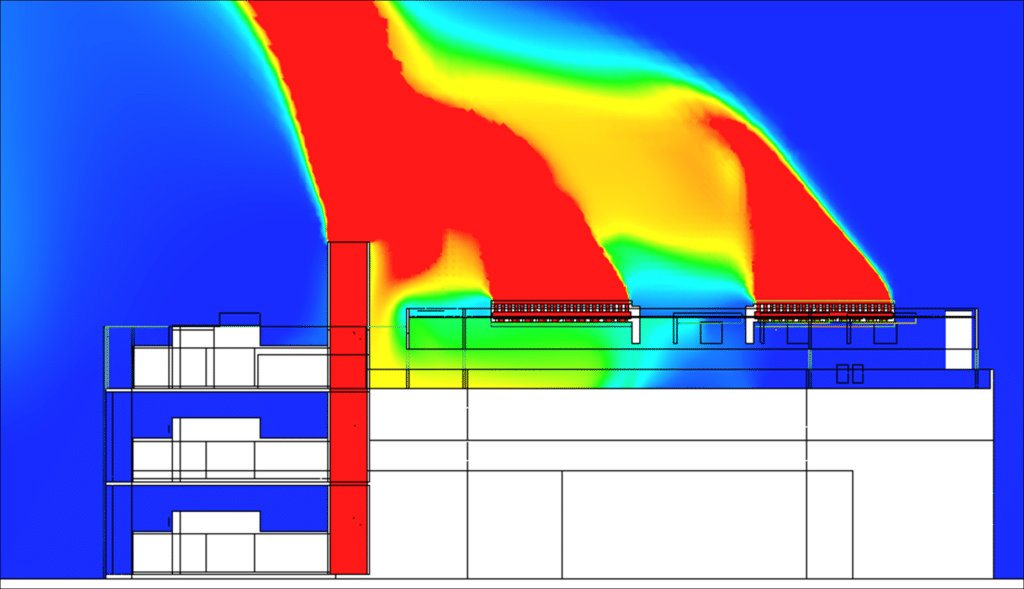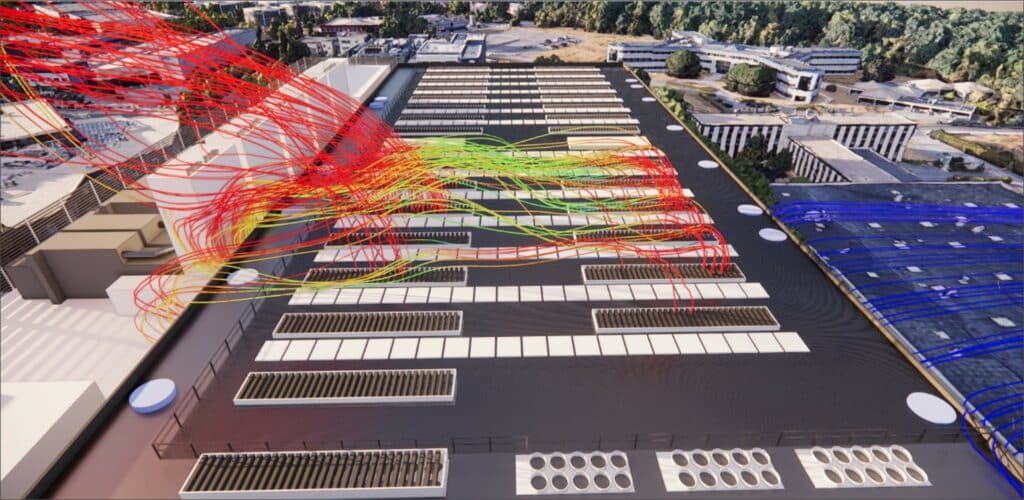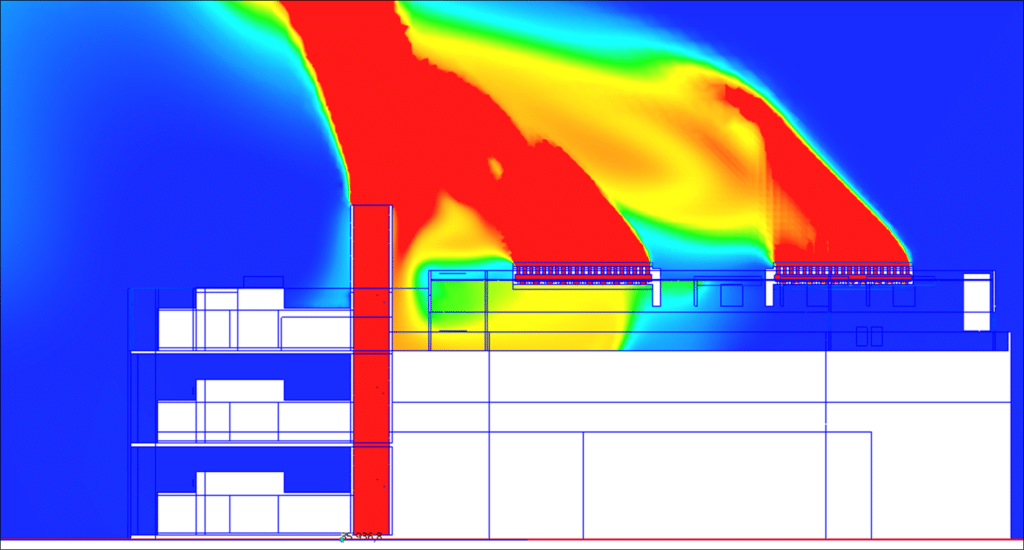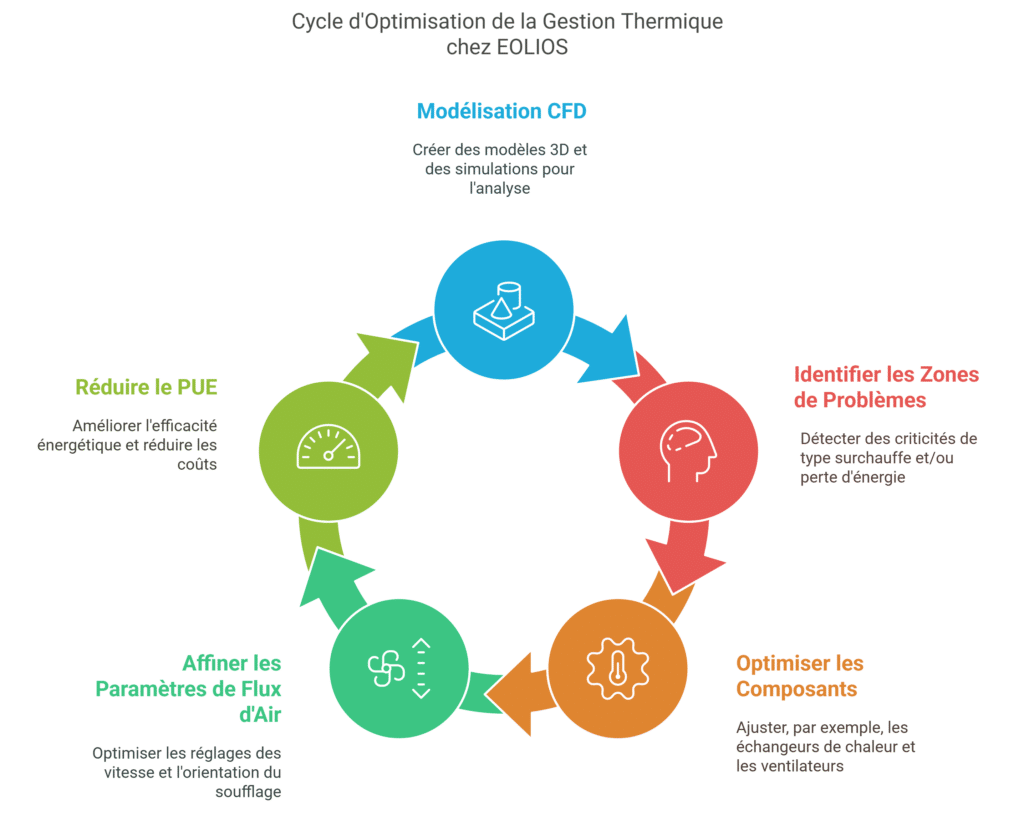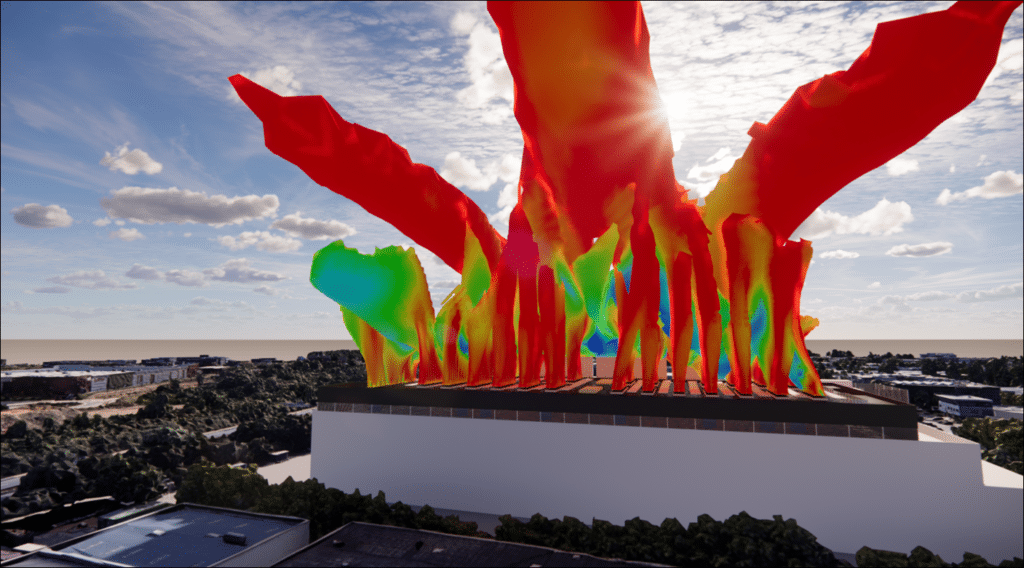Home » Data Center » External CFD simulation for data center » CFD Optimization – Data Center
CFD Optimization – Data Center
Thermal and aeraulic study of a Data Center: CFD expertise
As large-scale data centers multiply, the management of cooling systems becomes crucial, due to theincreasing density of IT equipment, often in excess of 10 kW per rack. The main challenge is to efficiently evacuate the heat generated by this high-density equipment. At EOLIOS, we put our technical expertise at your service by carrying out Computational Fluid Dynamics (CFD ) studies to model and optimize a data center’s thermal and aeraulic exchanges.
This analysis focuses specifically on external exhaust plumes from air coolers, generators and other rooftop equipment. The main objective is to verify whether thedischarge of thermal emissions from these systems risks contaminating the supply air through recirculation loops. We simulate the thermoaerodynamic behavior of these plumes using CFD numerical calculations, to ensure optimum management of inlet air temperature and prevent any interference problems.
The study aims to validate the building’s design and the location of the data center’s rooftop systems, checking that air temperatures at the chiller inlet are sufficiently low and identifying any recirculation problems.
It also includes different operating scenarios for high temperatures and different wind directions, as well as for starting up emergency generators. If a problem is detected, we identify the cause and propose appropriate corrective solutions.
CFD Optimization - Data Center
Year
2025
Customer
NC
Location
Frankfurt am Main
Typology
Data Center
Continue navigation :
Our other projects :
Latest news :
Technical file :
Our expertise:
ASHRAE climate data for CFD
Using standards for accurate and efficient CFD simulation
The correct parameterization of outdoor conditions is fundamental to optimizing the thermal management of data centers through CFD simulation.ASHRAE (American Society of Heating, Refrigerating and Air-Conditioning Engineers) is an essential international reference. By setting standards and providing accurate climatic data, it enables engineers and designers to adapt their heating, ventilation, air conditioning and refrigeration (HVAC-R) systems to real-life environments. ASHRAE collects meteorological data from thousands of stations around the world, guaranteeing reliability and accuracy thanks to average and extreme values measured over decades.
This data is essential for the proper dimensioning of outdoor systems. By taking into account average and extreme temperatures, they help to predict realistic scenarios, thus avoiding oversizing and optimizing energy efficiency. For our study, local climatic conditions are defined thanks to the nearest weather station, located in Toussus Le Noble. It provides crucial information, such as monthly temperatures and wind readings, which are decisive in defining weather conditions and establishing prevailing winds.
So, based on reliable, standard climate data, we can design efficient, long-lasting exterior systems that meet the requirements of different climatic conditions.
3D modeling of a data center for thermal-air simulation
The scenarios simulated in the external study are as follows:
- Standard scenario: With majority wind
- Scenario standard : With unfavorable wind
- Critical scenario: Unfavorable wind conditions
For these 3 studies, the generators are activated to take into account the most unfavorable situation in terms of heat emissions.
The cooling units, concentrated to the north-east of the building, comprise 30 chillers and 3 dry-coolers.
A roof overhang is fitted to the air cooler outlets to minimize air recirculation. This area is bounded by walls fitted with acoustic panels, and louvers are fitted to the lower parts of these walls.
Most of the 26 generators are located to the south-west of the building, both on the roof and spread over two floors inside. To divert waste heat from the generators, 5 exhaust ducts are installed high up.Fresh air for the generators isdrawn in through the building’s south-west façade, which is equipped with louvers.
The presence ofauxiliary equipment on the roof, such as air handling units and heat pumps, has also been taken into account.
Results of external data center simulation: Design validation
The study analyzed the exterior design of the data center through three critical scenarios, based on variations in wind direction and the management of cooling systems, while maintaining extreme climatic conditions according to ASHRAE standards.
Scenario 1: Majority wind - Standard scenario (N)
No significant air recirculation phenomena were detected in this scenario. The simulations reveal that the temperature measured at the intake of the cooling units remains close to the surrounding temperature, reflecting the optimized design of the air intake. The roof structure and layout are judged to be excellent under these conditions, guaranteeing good thermal regulation.
Scenario 2: Unfavorable wind - Standard scenario (N)
The study revealed a slight recirculation of air in the south-west vents, mainly due topartial obstruction by generator extraction ducts. However, a central area free of equipment provides sufficient access to fresh air, helping to mitigate this phenomenon. Intake temperature rises, particularly for systems located to the south, but remains under control. Generator exhaust ducts ensure effective detour of calorie-laden air, minimizing potential interactions with the air coolers.
Scenario 3: Adverse wind - Critical scenario (N+X)
Difficulties with air recirculation persist, exacerbated by the reduction in blowing speeds associated with full operating capacity. This increases the propensity for air recirculation, particularly around downstream fans. Suction temperatures rise significantly, mainly affecting units positioned to the south. Despite these conditions, theair drawn in by the generators remains at ambient temperature, thanks to skilful management of the detour of warm air masses.
The building’s roof design demonstrates sufficient resilience in the face of demanding climatic conditions. Even in the most unfavorable scenarios, such as northeast wind combined with full operational capacity, the overall design ensures adequate functionality and efficiency.
Energy optimization of air coolers using CFD simulation
At EOLIOS, we’re at the forefront ofenergy optimization for data centerair coolers, drawing on thetechnological edge provided by computational fluid dynamics (CFD) simulation.
CFD enables us to create sophisticated three-dimensional models that faithfully reproduce the thermal behavior andairflow within cooling systems. By analyzing these models, we can precisely identify areas of overheating and energy loss, andoptimize the configuration of heat exchangers and fans.
This approach enables us tofine-tune air circulation speed andflow orientation for each outdoor climatic condition, improvingenergy efficiency without compromising performance. What’s more, our solutions help reduce Power Usage Effectiveness (PUE), a key criterion for data centers, by ensuring more rational energy consumption and minimizing operating costs for our customers. We provide strategic recommendations for the implementation of robust and efficient thermal management systems.
Innovations in efficient roof design for data centers
At EOLIOS, we understand the crucial role of roof design, commonly referred to as the “fifth façade”, in theenergy efficiency of data centers. Our solutions include the creation of specially designed overroofs to passively improve ventilation and optimize thermal management. Using CFD simulation, we can model different overroof designs and analyze their impact on natural air circulation. This enables us to design structures that intelligently exploit prevailing winds and pressure variations to promote efficient cross-ventilation, reducing reliance on mechanical cooling systems and promoting theremoval of accumulated heat.
By incorporating reflective materials and innovative insulation technologies, our overroofs contribute to a significant reduction in thermal loads. In this way, we not only reduce the energy footprint of data centers, but also add a layer of climatic resilience, essential for guaranteeing continuity of operations in varying weather conditions.
A collaborative, tailor-made approach to your studies
EOLIOS demonstrates a particular ability to integrate the specific needs of companies throughout its design processes, establishing a truly collaborative partnership.
Based on an in-depth understanding of customers’ expectations and objectives, EOLIOS develops tailor-made solutions, adapted to the specific features of each request.
Through open and continuous communication, the company ensures that all stakeholders are aligned with project objectives and milestones. EOLIOS teams work hand in hand with companies, offering not only technical expertise but also relational know-how. Our customer-focused approach, combined with our specialist skills, ensures that the studies we carry out meet companies’ expectations, maximizing theeffectiveness and relevance of the solutions we propose.
EOLIOS - Expert data center design office
At EOLIOS, our mission is to support you in the design and evaluation of your data center cooling and ventilation systems, guaranteeing optimum efficiency and enhanced safety for your infrastructures. Drawing on our expertise in CFD simulation, we analyze thermo-aerodynamic dynamics to optimize thermal management.
Thanks to our knowledge of numerical simulations, we identify critical air flows and areas likely to create unwanted bypasses. By incorporating these analyses into our approach, we ensure optimal air distribution, reducing the risk of overheating in sensitive areas and promoting theoperational efficiency of your systems. We conduct rigorous assessments to validate and optimize the efficiency of your cooling systems, taking into account worst-case scenarios. This enables you to ensure the sustainability and performance of your data centers.
Continue on this topic
Video summary of the study
Summary of the study
The study focuses on theenergy optimization and thermal management of a data center using CFD simulation. It covers exterior design, including the integration of an overroof to passively improve ventilation. Through several critical scenarios, the study assesses theimpact of variations in wind direction and operational capacity on air recirculation andcooling system efficiency.
Sophisticated three-dimensional models analyze thermal behavior andairflow, pinpointing areas of overheating and optimizing system configurations. The overall design of the data center ensures functionality and resilience to demanding climatic conditions.
Theuse of over-roofing and reflective materials reduces thermal loads, while generator exhaust ducts efficiently divert hot air, minimizing interactions with air coolers. Thanks to a collaborative approach based on open communication and understanding of customer needs, EOLIOS offers tailor-made solutions that reduce Power Usage Effectiveness (PUE), guarantee business continuity, and add a layer of climate resilience.
Video summary of the mission
Discover other data center projects
Engineering smoke extraction in a data center
External & internal CFD – Data Center Hyperscale
CFD Optimization – Data Center
Data Center – DC28 – Internal
Pressure loss study – Generator – Data center
Data Center – PA 22 – External
Technical premises – Data Center
Cooling optimization – Data Center
Data Centers – DC15.1 & DC15.2 – External
Data Center – Paris
Data Center – GAZ NOVEC
Data center – DC25 – Internal
Data center – DC17 – Internal
Data Center – DC10 – Internal
Data center – DC25 & DC26 – External
Data center – D14 – External
Data center – DC17 – External
DC23 – External

